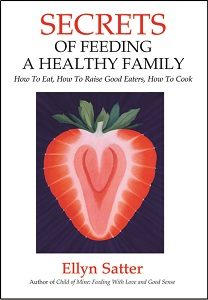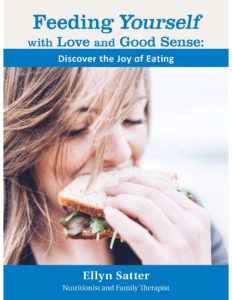

Family Meals Focus
The Ellyn Satter Institute Newsletter
ecSatter gets high marks for implementing the Dietary Guidelines
by Ellyn Satter, MS, MSSW, Dietitian and Family Therapist
For a PDF of this newsletter, click here.
The Dietary Guidelines for Americans 2020-2025 (DG 2020) has been published. Here are the recommendations for “what to eat and drink to promote health, reduce risk of chronic disease, and meet nutrient needs.”
- Breastfeed for 1 year, introduce nutrient-dense solids ~ 6 months.
- Consume nutrient-dense food and beverages. For the first time, uses the word “enjoy.”
- Meet nutrient-dense food-group needs within calorie limits. Groups include vegetables and fruits, grains (at least half whole-grain), low-fat dairy, lean and fat free protein foods, and vegetable oils.
- Limit added sugar and saturated fat to 10% of calories, sodium to 2,300 mg per day. Says to use alcohol in moderation.
ecSatter and fdSatter emphasize the joy of eating
The Dietary Guidelines is written for professionals. To be accessible to consumers, it has to be translated into practical terms. ecSatter is an example of Dietary Guidelines translation. MyPlate is another example. Since MyPlate makes rules for what and how much to eat, it is inconsistent with ecSatter and fdSatter.
Instead of counting, measuring, and avoiding, the Satter models follow a biospychosocial strategy that respects the biological need for enough to eat, the emotional need for preferred food, the nurturing need for a rewarding feeding relationship, and the social need for sharing with others familiar and culturally important food. In short, ecSatter emphasizes retaining the joy of eating. Feed yourself faithfully; give yourself permission to eat. Take time to eat, pay attention, and eat as much as you want of food you enjoy. Combining structure with food enjoyment allows eating to fall into place.
Even though ecSatter says nothing about what or how much to eat or what to weigh, people who are Eating Competent do better.
ecSatter and fdSatter successfully implement the Dietary Guidelines
ecSatter says nothing at all about what or how much to eat or what to weigh. However, people who are Eating Competent (those who score 32 and above on ecSI 2.0 TM) have better diets, lower BMIs, superior metabolic profiles, and more-positive quality of life indicators. Eating competence is measured by the validated ecSI 2.0 TM.1, 2
- Even though the Satter Division of Responsibility in Feeding (sDOR) says not to stipulate “healthy” food or try to get children to eat their vegetables, children and parents do better when parents follow sDOR. Higher scores on sDOR.2-6yTM correlate with lower child nutritional risk and improved parent quality of life.3 EC parents do better with respect to feeding their children.4, 5
- Even though ecSatter doesn’t say what to eat and, instead, encourages eating intrinsically rewarding food,6 EC people have high-quality, nutritious diets,7-10 and end up adhering more closely to the DG than the general population. EC people score 66 of 100 points on the Healthy Eating Index.10 That score compares with the general-population HEI score of 59 reported in the Dietary Guidelines 2020-2025 booklet.
- Even though ecSatter doesn’t say how much to eat and what to weigh, high EC are not heavier. They have the same or lower BMI than average.1, 7, 11, 12
- Even though ecSatter gives permission to eat high-fat, high-sugar food, EC people don’t overload on fatty and sugary food. Instead, they show Mediterranean13 and Prudent10 dietary patterns, have lower blood lipids and blood sugar and better oral hygiene.7, 9, 13, 14
Six steps to wellness based on ecSatter
Here is how you can apply the Dietary Guidelines to “eat and drink to promote health, reduce your risk of chronic disease, and meet nutrient needs.”
- Take time to eat. Have family meals and snacks between times made up of foods you enjoy and give yourself permission to eat.
- Eat food you enjoy. Use fat, sugar, and salt to make food tasty and rewarding. You will eat a variety of fruits, vegetables, grains, dairy, and protein foods because you enjoy them, not because you have You will also eat less sugar, salt, and fat.
- Trust yourself to learn and grow. The Satter hierarchy of food needs15 illustrates that when your basic food needs are satisfied, you tire of even favorite food and seek variety, which is the basis for a nutritionally excellent diet.
- Include your sugary beverages and “forbidden foods” at meals and snacks. Compared with munching and sipping along, you will consume less fat and sugar (and be kind to your teeth). Regularly including sugary, fatty foods at regular meals and snacks makes them less alluring and in the long run you consume less.
- Eat less saturated fat by using a variety of fats: margarine and mayonnaise; olive, canola oil, corn, or soybean oil along with butter, cream and gravy and butterfat in whole milk and cheese.
- Let your body weigh what it wants to weigh. Evidence shows that weight stability supports health; Weight yo-yoing doesn’t.
References
- Krall JS, Lohse B. Validation of a measure of the Satter eating competence model with low-income females. Int J Behav Nutr Phys Act. Apr 07 2011;8:26-36. doi:10.1186/1479-5868-8-26
- Lohse B, Satter E, Horacek T, Gebreselassie T, Oakland MJ. Measuring eating competence: psychometric properties and validity of the ecSatter Inventory. J Nutr Educ Behav. Sep-Oct 2007;39:S154-66. doi:10.1016/j.jneb.2007.04.371
- Lohse B, Satter E, Arnold K. Development of a tool to assess adherence to a model of the division of responsibility in feeding young children: using response mapping to capacitate validation measures. Child Obes. Apr 2014;10(2):153-68. doi:10.1089/chi.2013.0085
- Lohse B, Mitchell DC. Valid and Reliable Measure of Adherence to Satter Division of Responsibility in Feeding. JNEB. 2020;
- Tylka TL, Eneli IU, Kroon Van Diest AM, Lumeng JC. Which adaptive maternal eating behaviors predict child feeding practices? An examination with mothers of 2- to 5-year-old children. Eat Behav. Jan 2013;14:57-63.
- Satter E. Eating Competence: definition and evidence for the Satter Eating Competence Model. J Nutr Educ Behav. 2007;39:S142-S153. Computer.
- Tilles-Tirkkonen T, Aittola K, Männikkö R, et al. Eating Competence Is associated with lower prevalence of obesity and better insulin sensitivity in Finnish adults with increased risk for type 2 diabetes: The StopDia Study. Nutrients. Dec 30 2019;12(1)doi:10.3390/nu12010104
- Lohse B, Pflugh Prescott M, Cunningham-Sabo L. Eating competent parents of 4th grade youth from a predominantly non-Hispanic white sample demonstrate more healthful eating behaviors than non-eating competent parents. Nutrients. Jun 30 2019;11(7)doi:10.3390/nu11071501
- Lohse B, Masters L. Eating competence and oral health in Supplemental Nutrition Assistance Program eligible populations. J Dent Hyg. Dec 2019;93(6):42-50.
- Lohse B, Bailey RL, Krall JS, Wall DE, Mitchell DC. Diet quality is related to eating competence in cross-sectional sample of low-income females surveyed in Pennsylvania. Appetite. 2012;58:645-650. doi:10.1016/j.appet.2011.11.022
- Lohse B, Faulring K, Mitchell DC, Cunningham-Sabo L. A definition of “regular meals” driven by dietary quality supports a pragmatic schedule. Nutrients. Sep 1 2020;12(9)doi:10.3390/nu12092667
- Quick V, Shoff S, Lohse B, White A, Horacek T, Greene G. Relationships of eating competence, sleep behaviors and quality, and overweight status among college students. Eat Behav. Dec 2015;19:15-19. doi:10.1016/j.eatbeh.2015.06.012
- Lohse B, Psota T, Estruch R, et al. Eating competence of elderly Spanish adults is associated with a healthy diet and a favorable cardiovascular disease risk profile. J Nutr. 2010;140:1322-1327. doi:10.3945/jn.109.120188
- Psota TL, Lohse B, West SG. Associations between eating competence and cardiovascular disease biomarkers. J Nutr Educ Behav. Sep-Oct 2007;39(5 Suppl):S171-178. doi:10.1016/j.jneb.2007.05.004
- Satter E. Hierarchy of food needs. J Nutr Educ Behav. 2007;39 (5 suppl):S187-188.
Explore
Ellyn Satter’s Secrets of Feeding a Healthy Family says the secret of raising a healthy eater is to love good food, enjoy eating, and share that love and enjoyment with your child. When the joy goes out of eating, nutrition suffers.


